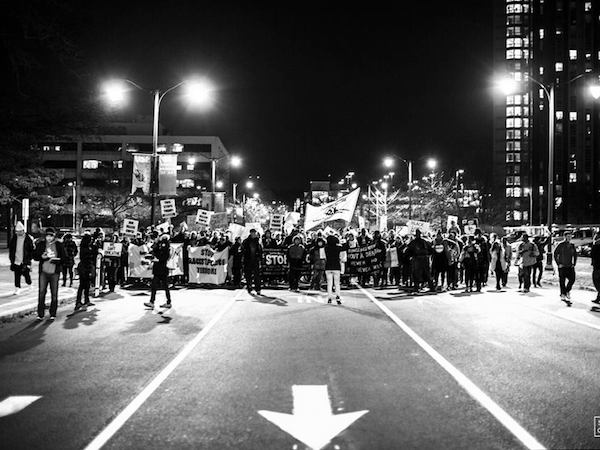Yes, Racism is Still a Problem at Syracuse University—and Elsewhere
 On Monday, April 27, shortly after the National Association of Latino Fraternal Organizations (NALFO) performed a step routine at its annual event “Stomp The Quad” near the entrance to Carnegie Library, a disturbing Yik Yak evoked campus-wide concern:
On Monday, April 27, shortly after the National Association of Latino Fraternal Organizations (NALFO) performed a step routine at its annual event “Stomp The Quad” near the entrance to Carnegie Library, a disturbing Yik Yak evoked campus-wide concern:
“Got really excited to see monkeys outside of Carnegie but there were just a bunch of black kids there. I wanted to see a fucking cute little marmoset.”
This is really disturbing and just downright scary. The app uses GPS trackers to display “yaks” made close to you. Although you don’t know who or where a post is coming from, you know it’s near (within a 10-mile radius).
The New York Times recently published a story titled “Who Spewed That Abuse? Anonymous Yik Yak App Isn’t Telling.” The feature highlights the social app’s wreaking power to anonymously spread racist, homophobic, and sexist thoughts—it’s essentially a breeding ground for abuse and hatred.
This Yik Yak post regarding the NALFO dance is deeply rooted in racism and suggests an urgent need for discussion. It also mirrors the concerns of the current national debate over race and policing.
On July 14 of last year, Eric Garner was caught allegedly selling untaxed cigarettes in New York City. The unarmed 42-year-old father of six and grandfather of two fought for his life as an NYPD officer held him in a tight, illegal chokehold. In a viral video recorded by a bystander, the man who suffered with diabetes and asthma is heard yelling, “I can’t breathe. I can’t breathe.”
As you should know, a nationwide outrage ensued.
Soon after Garner’s death, a teenager named Michael Brown was killed in Ferguson, Missouri and a new protest movement took shape: #BlackLivesMatter.
The recent loss of Freddie Gray, who died April 19 from a spinal cord injury while he was in police custody, sparked racial protests in the heart of Baltimore. Today, bricks and stones are hurled at police officers, car windows and storefronts are smashed to shards, and patrol cars are up in flames.
I’m not writing to justify the rebellion—neither am I here to say it’s “wrong.” What I can comment on, though, is the fact that racism still exists today.
A recent study done by ProPublica reported that black male teens were 21 times more likely to be killed by cops than white males teens. Let’s drop a few names of unarmed men who died in the past year as a result of police brutality: John Crawford. Dante Parker. Kimani Gray. Darrien Hunt. Ezell Ford. Omar Abrego. Tamir Rice. Rumain Brisbon. Keith Vidal. Kajieme Powell. Akai Gurley. Jack Jacquez. Jason Harrison. Louis Rodriguez. Matthew Pollow. Dontre Hamilton. David Latham. And Trayvon Martin, killed by a member of his neighborhood's community watch. The list goes on, and on, and on.
African-American males are easily targeted by polices enforced through institutionalized racism, like the War On Drugs, the stop-and-frisk law, and the prison industrial complex. The stop-and-frisk rule grants police officers immunity to search individuals for drugs based on “suspicion” (aka the way they dress, walk, talk, and look). This opens the floodgates for discriminatory practices.
In the days of Jim Crow, there were signs explicitly stating “Whites Only.” Now that signs have been removed, many Americans deem systematic oppression out of sight and out of mind. Racism, however, has not disappeared—it has merely changed form. Structural and institutionalized racism exists within America’s police forces—it’s a national crisis that begs for attention and discussion.
Racism is very much alive and thriving. It’s unacceptable and should not be tolerated.
Back to—last September, Syracuse University women’s soccer player Hanna Strong was suspended from the team after her racist and homophobic rant was filmed and released online.
Sadly, the SU campus is not the only university flooded with racism. The Sigma Alpha Epsilon fraternity at the University of Oklahoma stole the spotlight a few months back when a video packed with bigoted chants went viral. In addition, the University of Maryland recently opened an investigation that involves an email filled with racial epithets from a brother of the Kappa Sigma fraternity.
So, now what? Well, a civil rights lawyer and author of “The New Jim Crow” Michelle Alexander dares the world to challenge the public consensus that “being a criminal equals being black.” She declares that for change, “colorblindness” needs to be exposed in an honest and transparent discussion on race.
At SU, I urge the chancellor, faculty, and students to initiate and enforce more open conversations. We’ve already had light talks on race when it seemed necessary, but I believe that daily conversations are needed to feed the revolution.
Student activists have organized a rally in solidarity with the Baltimore rebellion meeting at Hendricks Chapel on Thursday, April 30 at noon. President Obama, members of our campus, and media sources have labeled protestors and male minorities "thugs," "monkeys," and "animals"—united, we must fight to end racism and state oppression. We must join hands and to protect our brothers and sisters from white supremacist hate.
Take a look at a Facebook video, from19-year-old spoken-word poet Sarah O’Neal, where she recites her poem “An Overreaction,” expressing her frustration at having to defend the Baltimore uprising. Her words resonate, and make a formidable stance that we should all heed: “All lives will matter when black lives matter.”
And that message must ring true whether in Baltimore, NYC, or on the SU campus.
Photo courtesy of Solon Quinn Photography

